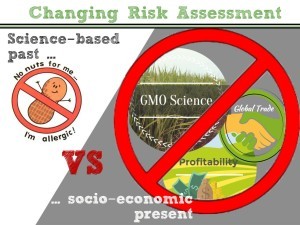Risk impacts all aspects of life. Typically the riskiest thing we do every day is drive to work. Traditionally, risks have been evaluated by the size of their hazard and by how long we are exposed to it. This is why an x-ray is classified as safe for human use. Our exposure to x-rays are a low dose for a couple of seconds, resulting in a low level of risk. Risk is a manageable part of everyday life.
In recent years, there has been an effort to shift risk assessment away from science-based evaluation of hazards and exposures to a more broadly encompassing definition, particularly as it relates to agricultural crops and food production. The rational for these efforts is that there should be zero tolerance for risk when it relates to the food we consume. The reality is that risk is all around us, everything has risks associated with it and it is impossible to have a product, food or otherwise, that has zero risk associated with it.
So how are risks in food products evaluated? When it comes to assessing the safety of food products, the standard risk assessment includes a measure of how toxic a known substance is and whether it triggers allergic reactions in people. For example, eating a peanut is so toxic to some people that they have been known to die in a matter of minutes. Obviously, this is relatively rare in society, but it identifies that regardless of how careful the food industry is, there are always individuals in society that will be at a higher risk than others. People with a higher exposure risk become sick from eating food as a result of longer lengths of time required to break down specific proteins in their stomachs. Most food proteins break down within our stomachs relatively quickly. However, when proteins take longer to break down, this is when individuals can start to develop allergic reactions to them.
Understanding risks regarding food has become a societal concern, and changes to risk assessment are being made. However, these changes are not improvements to our ability to measure the time it takes proteins to break down once we digest them, but all kinds of social and economic factors that have no relationship to food safety. For example, many critics of genetically modified (GM) crops argue that risk assessments should include things like farm profitability, changes in labour patterns, ability to export the crop and is the crop patented. While these are important issues that are worthy of discussion and debate, they have absolutely no relationship to improving food safety. Including issues such as these in a risk assessment process, adds considerable additional time and cost to the development of new crops. In many developing countries, new crops are developed by publicly funded agriculture research centers, thus making it more costly for these public centers to commercialize their technologies.
Organizations like Greenpeace, Friends of the Earth, The Third World Network and the Sierra Club all advocate that socio-economic factors should be part of assessing the risks of new GM crops and food products. All of these organizations are interested in making it more difficult for governments in developing countries to approve the use of GM crops in their own country. Most developing countries face food security problems. To allow developing countries to improve their food security, access to GM crops needs to be based on scientific risk assessments and not include socio-economic issues that have no relationship to food safety.


Great post. I think most of the food safety assessments are more economic/political rather than scientific. Many GM crops have been introduced to the USA market ten of years ago, to date no scientific evidence support the claim that GM crops are unsafe.
On another note, we claim that the problem of food security in related to the availability of food, in fact I do believe there is no shortage in the food supply, it is all about accessibility and affordability. In 2013, half of all food is wasted worldwide. Then do we really need more food or we need to find a way to distribute the food we already produce.
Pingback: Withdraw Could be a Winning Solution for Developing Countries - Sustainable Agricultural Innovations & Food